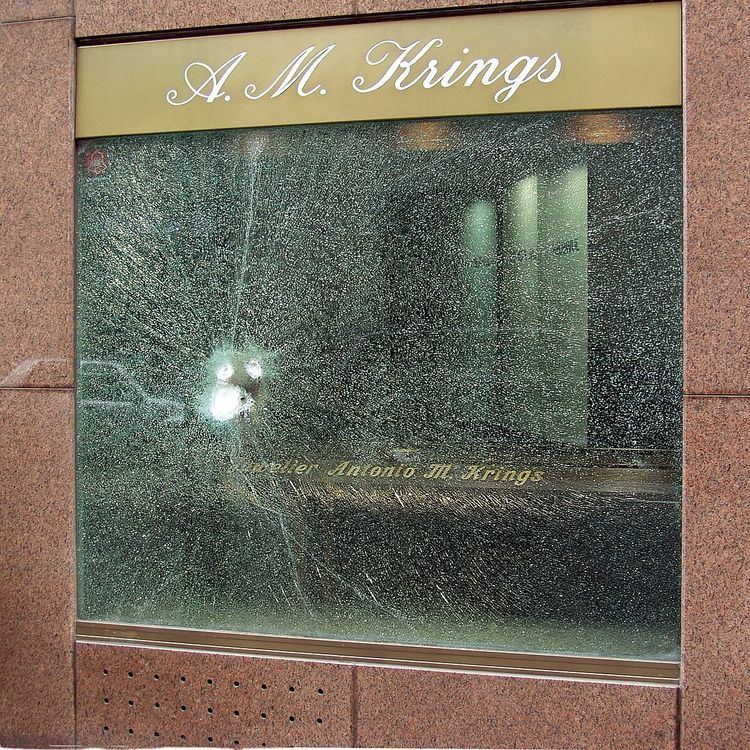 | ||
Bulletproof glass (also known as ballistic glass, transparent armor, or bullet-resistant glass) is a type of strong but optically transparent material that is particularly resistant to being penetrated when struck. Like any material, however, it is not completely impenetrable. It is usually made from a combination of two or more types of glass, one hard and one soft. The softer layer makes the glass more elastic, so it can flex instead of shatter. The index of refraction for both of the glasses used in the bulletproof layers must be almost the same to keep the glass transparent and allow a clear, undistorted view through the glass. Bulletproof glass varies in thickness from 3⁄4 to 3 1⁄2 inches (19 to 89 mm).
Contents
- Construction
- Test standards
- Environmental effects
- Recent advances
- Spinel ceramics
- Air Chamber Glass
- References
Bulletproof glass is used in windows of buildings that require security, such as jewelry stores and embassies, as well as military and private vehicles.
Construction
Bullet-resistant glass is constructed using layers of laminated glass. The more layers the higher the protection. When a weight reduction is needed 3mm of polycarbonate (a thermoplastic) is laminated onto the safe side. This polycarbonate stops the spall. The aim is to make a material with the appearance and clarity of standard glass but with effective protection from small arms. Polycarbonate designs usually consist of products such as Armormax, Makroclear, Cyrolon, Lexan or Tuffak, which are often laminated as the final layer (Glass clad Polycarbonate).
The polycarbonate usually has one of two types of coating to resist abrasion: a soft coating that heals after being scratched (such as elastomeric carbon-based polymers) or a hard coating that prevents scratching (such as silicon-based polymers).
The plastic in laminate designs also provides resistance to impact from physical assault from blunt and sharp objects. The plastic provides little in the way of bullet-resistance. The glass, which is much harder than plastic, flattens the bullet, and the plastic deforms, with the aim of absorbing the rest of the energy and preventing penetration. The ability of the polycarbonate layer to stop projectiles with varying energy is directly proportional to its thickness, and bulletproof glass of this design may be up to 3.5 inches thick.
Laminated glass layers are built from glass sheets bonded together with polyvinyl butyral, polyurethane, Sentryglas or ethylene-vinyl acetate. When treated with chemical processes, the glass becomes much stronger. This design has been in regular use on combat vehicles since World War II. It is typically thick and is usually extremely heavy.
Test standards
Bullet-resistant materials are tested using a gun to fire a projectile from a set distance into the material, in a specific pattern. Levels of protection are based on the ability of the target to stop a specific type of projectile traveling at a specific speed. Experiments suggest that polycarbonate fails at lower velocities with regular shaped projectiles compared to irregular ones (like fragments), meaning that testing with regular shaped projectiles gives a conservative estimate of its resistance. When projectiles do not penetrate, the depth of the dent left by the impact can be measured and related to the projectile’s velocity and thickness of the material. Some researchers have developed mathematical models based on results of this kind of testing to help them design bulletproof glass to resist specific anticipated threats.
Well known standards for categorizing ballistic resistance include the following:
Environmental effects
The properties of bullet-resistant glass can be affected by temperature and by exposure to solvents or UV radiation, usually from sunlight. If the polycarbonate layer is below a glass layer, it has some protection from UV radiation due to the glass and bonding layer. Over time the polycarbonate becomes more brittle because it is an amorphous polymer (which is necessary for it to be transparent) that moves toward thermodynamic equilibrium.
An impact on polycarbonate by a projectile at temperatures below −7 °C sometimes creates spall, pieces of polycarbonate that are broken off and become projectiles themselves. Experiments have demonstrated that the size of the spall is related to the thickness of the laminate rather than the size of the projectile. The spall starts in surface flaws caused by bending of the inner, polycarbonate layer and the cracks move “backwards” through to the impact surface. It has been suggested that a second inner layer of polycarbonate may effectively resist penetration by the spall.
Recent advances
In 2005 it was reported that U.S. military researchers were developing a class of transparent armor incorporating aluminum oxynitride (ALON) as the outside "strike plate" layer. ALON is much lighter and performs much better than traditional glass/polymer laminates. Aluminum oxynitride "glass" can defeat threats like the .50 caliber armor-piercing rounds using material that is not prohibitively heavy. Various types of other materials which closely resemble glass are also being developed.
Spinel ceramics
Certain types of ceramics can also be used for transparent armor due to their properties of increased density and hardness when compared to traditional glass. These types of synthetic ceramic transparent armors can allow for thinner armor with equivalent stopping power to traditional laminated glass.
Air Chamber Glass
The newest type of curved transparent vehicle armor has an air chamber between the glass and the polycarbonate. Level IIIA (high speed 9mm) armor consists 8mm of laminated glass (strike face) a 1mm air gap and 7mm of polycarbonate. This solution stops the bullets in a total different way. The glass being hard deforms the incoming bullet. The deformed bullet completely penetrates the glass and then it is stopped by the flexible polycarbonate. The weight reduction over traditional glass clad polycarbonate is 35% weighing 28 kilos per square meter. It is also thinner (16.2mm). The picture on the right shows how the bullet is embedded between the glass and the polycarbonate.
